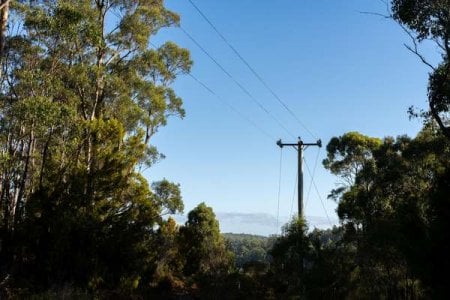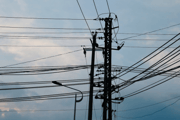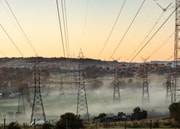Power payback: Government compensation plan sparks voltage of Emotion in Victoria!
- Replies 2
The picturesque landscapes of Victoria are a source of pride for many landowners, offering serene views that are quintessentially Australian.
However, the march of progress, particularly in the form of new power transmission lines, can sometimes mar these vistas, leading to a loss of visual amenities for property owners.
Recognising this, the Victorian government proposed a plan that would compensate affected landowners for their spoiled views.
Under the scheme being considered, VicGrid, the new transmission planning agency, initiated a consultation process to establish a community benefits scheme.
This initiative would require power companies to contribute funds to give one-time compensation to communities impacted by the construction of new transmission lines.
The proposed compensation is substantial for those with transmission lines constructed directly on their properties, amounting to as much as $40,000.

Under the proposed community benefits scheme, eligible residents could receive $200,000 per kilometre, distributed in annual instalments of $8,000 over a 25-year period, indexed to inflation.
This long-term payment plan acknowledges the enduring impact such infrastructure can have on property values and residents' daily lives.
Meanwhile, neighbouring properties that are ‘significantly impacted’ by the presence of these new or upgraded transmission lines are also set to benefit.
Rural blocks within 400 metres and urban properties within 200 metres of the projects could be eligible for a one-off payment of up to $40,000.
Government minister Harriet Shing emphasised the significance of the community benefits scheme in ‘developing, securing and maintaining the social license that is necessary to be able to do this work’.
‘This is about partnering with communities, partnering with landholders. When we do this work to create the infrastructure necessary to deliver new energy across the grid as our population grows, it’s only fitting that we make an investment into the communities where that impact is being felt,’ she stated.
To qualify, property owners must demonstrate a ‘significant loss of visual amenity including surrounding natural landscape’ with the power lines being ‘clearly visible from the point of the dwelling, home occupation or other site of sensitive land use’.
The amount of compensation is designed to decrease the further the property is from the transmission lines, reflecting the lesser impact on more distant views.
VicGrid was also soliciting input regarding an ‘exceptional circumstances’ provision, which could entail compensating property owners with sums exceeding $40,000.
These circumstances might involve ‘impacts to culturally significant sites or practices’, as well as losses incurred by hospitality and tourism establishments due to any alterations.
Additionally, under the proposed plan, funds would be allocated to regional communities and traditional owners.
This initiative comes in the wake of backlash from communities across western Victoria regarding two major proposals: the Victoria to NSW Interconnector West (VNI West) and the Western Renewables Link, aimed at transmitting renewable energy from a power plant in Bulgana, western Victoria, to Sydenham in Melbourne’s northwest.
Over the past few years, communities have been actively opposing these projects, which would span hundreds of kilometres and feature poles reaching heights of up to 85 metres in certain areas.
Liberal MP Brad Roswell expressed he was ‘thrilled’ that the government was contemplating compensation, yet criticised the delayed commencement of community consultations, suggesting they should have commenced years earlier.
‘You can’t begrudge someone for wanting compensation from a government who was frankly stuffed the process over the last 10 years,’ he stated.
While critics have called for the lines to be built underground or rerouted, the Australian Energy Market Operator (AEMO) argued that alternative proposals would be prohibitively expensive.
AEMO projected that Australia will require over 10,000km of new transmission lines and a ninefold increase in large-scale renewable energy to meet climate targets and move towards a zero-emissions future.
According to VicGrid's consultation document, the shift to net zero emissions would result in ‘unprecedented new investment in renewable energy generation, transmission and storage projects’ in renewable energy generation, transmission, and storage projects.
Additionally, it would offer ‘growth opportunities’ for regional areas, which would host the majority of these developments.
‘However, it is important that host communities are involved in decision-making from the outset and to ensure that they receive direct benefits from hosting this critical infrastructure,’ it stated.
‘Through community engagement so far, we know more needs to be done to achieve better outcomes for hosting communities and deliver lasting benefits that are flexible, responsive, community-focused and shared fairly.’
The consultation process for the community benefits scheme is set to close on June 16, with a final plan to be published in late 2024.
Following this, a bill to create the community benefit scheme is expected to be introduced into the Victorian parliament in early 2025.
As discussions surrounding compensation for landowners affected by power lines intensify, it's essential for residents, especially seniors, to explore avenues that can alleviate financial burdens.
One such opportunity arises with a potential $500 bonus aimed at assisting households with various expenses.
Delving into eligibility criteria and application processes could provide much-needed relief for seniors grappling with rising costs.
 Have you been affected by the construction of power lines or other infrastructure projects? Do you think the compensation is adequate? Share your experiences and opinions in the comments below.
Have you been affected by the construction of power lines or other infrastructure projects? Do you think the compensation is adequate? Share your experiences and opinions in the comments below.
However, the march of progress, particularly in the form of new power transmission lines, can sometimes mar these vistas, leading to a loss of visual amenities for property owners.
Recognising this, the Victorian government proposed a plan that would compensate affected landowners for their spoiled views.
Under the scheme being considered, VicGrid, the new transmission planning agency, initiated a consultation process to establish a community benefits scheme.
This initiative would require power companies to contribute funds to give one-time compensation to communities impacted by the construction of new transmission lines.
The proposed compensation is substantial for those with transmission lines constructed directly on their properties, amounting to as much as $40,000.

Victorian landowners affected by new power lines could receive compensation of up to $40,000 under a proposed government plan. Credits: Shutterstock
Under the proposed community benefits scheme, eligible residents could receive $200,000 per kilometre, distributed in annual instalments of $8,000 over a 25-year period, indexed to inflation.
This long-term payment plan acknowledges the enduring impact such infrastructure can have on property values and residents' daily lives.
Meanwhile, neighbouring properties that are ‘significantly impacted’ by the presence of these new or upgraded transmission lines are also set to benefit.
Rural blocks within 400 metres and urban properties within 200 metres of the projects could be eligible for a one-off payment of up to $40,000.
Government minister Harriet Shing emphasised the significance of the community benefits scheme in ‘developing, securing and maintaining the social license that is necessary to be able to do this work’.
‘This is about partnering with communities, partnering with landholders. When we do this work to create the infrastructure necessary to deliver new energy across the grid as our population grows, it’s only fitting that we make an investment into the communities where that impact is being felt,’ she stated.
To qualify, property owners must demonstrate a ‘significant loss of visual amenity including surrounding natural landscape’ with the power lines being ‘clearly visible from the point of the dwelling, home occupation or other site of sensitive land use’.
The amount of compensation is designed to decrease the further the property is from the transmission lines, reflecting the lesser impact on more distant views.
VicGrid was also soliciting input regarding an ‘exceptional circumstances’ provision, which could entail compensating property owners with sums exceeding $40,000.
These circumstances might involve ‘impacts to culturally significant sites or practices’, as well as losses incurred by hospitality and tourism establishments due to any alterations.
Additionally, under the proposed plan, funds would be allocated to regional communities and traditional owners.
This initiative comes in the wake of backlash from communities across western Victoria regarding two major proposals: the Victoria to NSW Interconnector West (VNI West) and the Western Renewables Link, aimed at transmitting renewable energy from a power plant in Bulgana, western Victoria, to Sydenham in Melbourne’s northwest.
Over the past few years, communities have been actively opposing these projects, which would span hundreds of kilometres and feature poles reaching heights of up to 85 metres in certain areas.
Liberal MP Brad Roswell expressed he was ‘thrilled’ that the government was contemplating compensation, yet criticised the delayed commencement of community consultations, suggesting they should have commenced years earlier.
‘You can’t begrudge someone for wanting compensation from a government who was frankly stuffed the process over the last 10 years,’ he stated.
While critics have called for the lines to be built underground or rerouted, the Australian Energy Market Operator (AEMO) argued that alternative proposals would be prohibitively expensive.
AEMO projected that Australia will require over 10,000km of new transmission lines and a ninefold increase in large-scale renewable energy to meet climate targets and move towards a zero-emissions future.
According to VicGrid's consultation document, the shift to net zero emissions would result in ‘unprecedented new investment in renewable energy generation, transmission and storage projects’ in renewable energy generation, transmission, and storage projects.
Additionally, it would offer ‘growth opportunities’ for regional areas, which would host the majority of these developments.
‘However, it is important that host communities are involved in decision-making from the outset and to ensure that they receive direct benefits from hosting this critical infrastructure,’ it stated.
‘Through community engagement so far, we know more needs to be done to achieve better outcomes for hosting communities and deliver lasting benefits that are flexible, responsive, community-focused and shared fairly.’
The consultation process for the community benefits scheme is set to close on June 16, with a final plan to be published in late 2024.
Following this, a bill to create the community benefit scheme is expected to be introduced into the Victorian parliament in early 2025.
As discussions surrounding compensation for landowners affected by power lines intensify, it's essential for residents, especially seniors, to explore avenues that can alleviate financial burdens.
One such opportunity arises with a potential $500 bonus aimed at assisting households with various expenses.
Delving into eligibility criteria and application processes could provide much-needed relief for seniors grappling with rising costs.
Key Takeaways
- Victorian landowners impacted by the visual presence of new power lines may receive compensation of up to $40,000 under a proposed government scheme.
- VicGrid, a new transmission planning agency, consulted on a community benefits scheme funded by power companies for affected communities.
- Payments for landowners with transmission lines on their property could be $200,000 per kilometre, paid as annual index-linked instalments over 25 years.
- There is ongoing backlash from communities over proposed high-voltage power line projects, sparking demand for compensation and consideration of alternative routing or underground lines.







